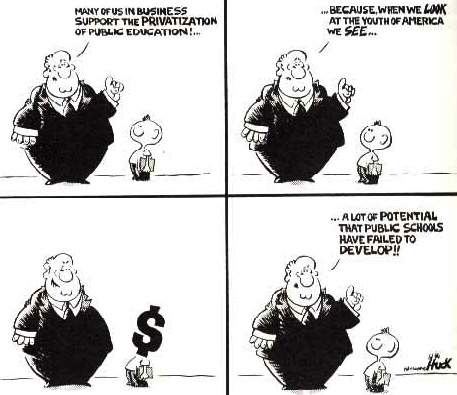School districts and charter schools in the US may contract out the management of schools to EMOs. In 2008 there were more than 60 for-profit EMO companies operating more than 550 schools in 28 states including the District of Columbia, attended by more than 250,000 students. Fifteen large EMOs operated over 80 per cent of them. Most EMO contracts are with charter schools, 85 per cent in 2008, including 40 virtual schools.
The largest profitable EMO is National Heritage Academies, a private company that has 55 charter schools in six states covering 33,000 students. It was founded in 1995 by industrialist J.C. Huizenga, who invested $50 million. Edison manages 80 schools in 17 states covering 48,600 students.

In 1986 former Xerox salesman, John Golle, set up Education Alternatives Inc (EAI), one of the pioneers of for-profit schooling companies. Golle claimed “There’s so much fat in the schools that even a blind man without his cane could find the way”.
In 1994 it had contracts to run 45 public schools, including 9 schools in Baltimore, and all 32 Hartford public schools. Its effort to cut 300 teachers from the Hartford schools so as to increase profitability were unsuccessful. In Baltimore it had to repay money after being caught falsifying enrolment figures.
 By 1997 EAI had lost all its school management contracts because of contractual disputes and because it failed to improve learning despite the extra funding it received compared with other public schools. It changed its name to Tesseract, moved to Arizona and began 12 charter schools in Phoenix. Despite its inability to make a profit, its plummeting share price, and its multimillion dollar debt, Golle make millions from the company. Tesseract filed for bankruptcy in 2001.
By 1997 EAI had lost all its school management contracts because of contractual disputes and because it failed to improve learning despite the extra funding it received compared with other public schools. It changed its name to Tesseract, moved to Arizona and began 12 charter schools in Phoenix. Despite its inability to make a profit, its plummeting share price, and its multimillion dollar debt, Golle make millions from the company. Tesseract filed for bankruptcy in 2001.
During the 1990s for-profit EMOs were promoted as a hot investment. “Venture capital firms envisioned high returns and invested millions of dollars”.
In 2000 Business Week reported: “Big-name investors are subscribing to this vision, lured by the prospect of getting on the ground floor of an entirely new industry. From J.P. Morgan and Fidelity Ventures to Paul Allen’s Vulcan Ventures, a host of backers are sinking millions into the new school companies in the belief that for-profit education is poised for explosive growth.”

Investors assumed that schools were inefficiently run, spending too much on bureaucratic administration and not enough on student learning. However funding cuts during the previous two decades had eliminated any fat there may have been in the public school system. As a result, few companies have been able to make a profit from running schools.
In 2002 Fortune magazine reported that the only profitable EMOs were Nobel Learning Communities that mainly ran private schools and National Heritage Academies that ran “quasi-religious schools”.
The difficulty that EMOs have experienced in making profits from managing schools whilst at the same time improving student test scores has led many EMOs to focus more on supplementary educational services such as after school classes, summer schools and consultancy services.
EMOs are not popular outside conservative policy circles. A 2002 Phi Delta Kappa-Gallup poll found that 65 percent of those surveyed would oppose any proposal by their local school board “contract[ed] with private profit-making corporations to run the entire operations of the public schools”.
If you have any examples or updates you would like to contribute please email them to me and I will add them here. Please give references for where you sourced the information.